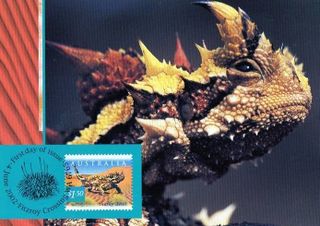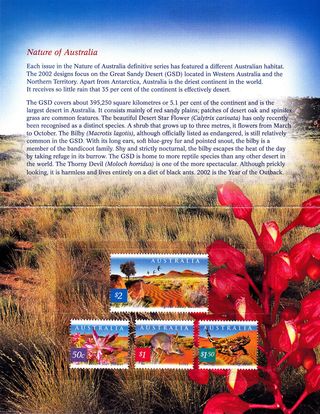Australia 2002 Nature of Australia - Desert
- Issue Date: 4 June 2002
- Designed by: Wayne Rankin
- Print Process: Lithography
- Stamp Size: 30 mm x 25 mm, 50 mm x 30 mm ($2)
Contents
Description
The desert habitat was introduced in August 2001 with the Desert Birds issue. Australia’s major deserts are distributed throughout the western plateau and interior lowlands. About 18 per cent of mainland Australia is desert.
Spinifex grass (genus Triodia) is used as a motif connecting the four designs. Spinifex grassland is the single most extensive type of vegetation in Australia, covering more than 20 per cent of the continent. In a country known for its infertile soils, spinifex thrives on some of the poorest soils in Australia, including the parched sands of the Great Sandy Desert.
Stamps
Sheet Stamps
- Printed by: SNP Ausprint
- Perforations: 14 by 14½, 14½ x 14 ($2)
- Format: sheets of 50
50c Desert Star Flower Stamp
With its spectacular pink or purple flowers this shrub grows up to three metres high and flowers from March to October. It is found on red sand or gravelly rust-coloured clay.
 50c Desert Star Flower (Calytrix carinata) |
$1 Bilby Stamp
A member of the bandicoot family, the bilby has long ears, soft blue-grey fur and a pointed snout. Once found throughout arid and semi-arid Australia, it is now confined to northern deserts and is a threatened species.
$1.50 Thorny Devil Stamp
The Great Sandy Desert has more reptile species than any other desert in the world and the thorny devil is one of the more spectacular reptiles found there. Despite its appearance the thorny devil is harmless. It grows to about 20 cm in length and lives entirely on a diet of black ants.
$2 Great Sandy Desert Stamp
The Great Sandy Desert is in Western Australia and the Northern Territory. It covers about 395,250 km sq, or 5.1 percent of Australia and is the largest desert in Australia. The region is located more than 900 km northeast of Perth and is bordered by the Little Sandy Desert, Gibson Desert and Central Ranges in the south, and the Kimberley in the north. The region consists mainly of sand plains and dunes covered with spinifex, with patches of desert oak. This landscape is relieved by emergent sandstone hills and chains of ephemeral salt lakes.
The designer has used the powerful red earth and blue sky to evoke the intensity and atmosphere of the Great Sandy Desert’s landscape and habitat. Sand dunes – powerfully evocative of the Great Sandy Desert, desert oaks (Allocasuarina decaisneana), and white-backed swallows (Cheramoeca leucosterna) feeding gracefully in the distance – provide dramatic points of interest.
Self-adhesive Stamps
- Issue date: 7 January 2003
- Printed by: SNP Ausprint, Pemara Labels
- Perforations:
- Format: booklets of 10
Single Stamps
File:Australia 2002 Nature of Australia - Desert sa Pemara.jpg 50c Desert Star Flower - Pemara Labels |
Booklet
First Day Cover
The first day of issue postmark was Fitzroy Crossing WA 6765.
Maximum Cards













